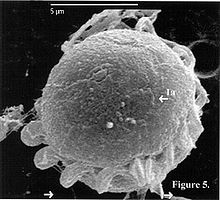Pseudopfiesteria shumwayae
| Pseudopfiesteria shumwayae | |
|---|---|

| |
| Pseudopfiesteria shumwayae SEM micrograph | |
| Scientific classification | |
| Domain: | Eukaryota |
| Clade: | Diaphoretickes |
| Clade: | SAR |
| Clade: | Alveolata |
| Phylum: | Myzozoa |
| Superclass: | Dinoflagellata |
| Class: | Dinophyceae |
| Order: | Thoracosphaerales |
| Family: | Pfiesteriaceae |
| Genus: | Pseudopfiesteria |
| Species: | P. shumwayae
|
| Binomial name | |
| Pseudopfiesteria shumwayae Glasgow & Burkholder
| |
Pseudopfiesteria shumwayae (formerly placed in the genus Pfiesteria; see 'Taxonomy' section below) is a species of
Toxicity
While toxic strains of Pseudopfiesteria shumwayae have been implicated in fish kills, its ability to secrete an exotoxin to kill its prey has been subject to controversy.[3] A study published in 2002 has shown that it is capable of killing fish by direct contact and feeding on their skin through micropredation.[4] Toxicity levels appear to depend on the strains and assays used in the laboratory.[5] Pfiesteria shumwayae toxin present in filtered water can cause cognitive deficits in rats.[6]
Taxonomy
Based on 2005 research, the organism previously known as Pfiesteria shumwayae should be reassigned its own genus, based on both morphological analysis and molecular evidence as supported by rDNA analysis. Although closely resembling Pfiesteria piscicida, it differs in two important precingular plates 5" and 6", which historically, only one plate difference would be sufficient to place in a separate genus. The species ' shumwayae ' has thus been categorized in a more recently erected genus, Pseudopfiesteria.[7]
Occurrence
Pfiesteria has a worldwide distribution and is typically found in estuaries and coastal habitats. It is usually benign unless it "blooms" to a high concentration. High concentrations of Pseudopfiesteria shumwayae have been found in the following locations:
References
- ^ "NC State News Release, March 10, 2000: NC State Scientists Confirm Second Toxic Pfiesteria Species". Archived from the original on March 18, 2007. Retrieved 2008-01-06.
- PMID 11677174.
- PMID 12648722.
- S2CID 4388577.
- PMID 15728353.
- PMID 16198085.
- ^ "Archived copy" (PDF). Archived from the original (PDF) on 2011-07-20. Retrieved 2011-02-15.
{{cite web}}: CS1 maint: archived copy as title (link) - ^ "Chesapeake Bay Foundation - Save the Bay: High Concentrations of Pfiesteria Underscore Need to Reduce Pollution". Archived from the original on 2007-09-28. Retrieved 2008-01-06.
This article needs additional or more specific categories. (April 2022) |
